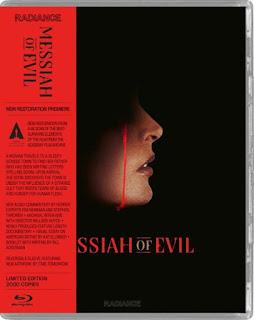Messiah of Evil
Messiah of Evil (1974) exists in that rare sub-genre: the counter-culture horror movie. Typically more philosophical than overtly frightening, the films utilize a dream-logic that mirrors the experience of a bad acid trip. But directors Willard Huyck and Gloria Katz also incorporate some visually dramatic set-pieces proving their commercial aspirations were just as genuine as their psychedelic inspirations.
Arriving in Point Dune to reconnect with her artist father, Arletty gets the cold shoulder from residents who seem to be keeping his location a secret. Meanwhile another trio of eccentric travelers have stirred up trouble by asking questions about the town’s supernatural history involving an incident of mass hysteria that dates back over 100 years. Now it seems that a “dark stranger” is returning to finish what he started…and Point Dune is just a test case for global apocalypse.
There’s a lot to “unpack” in Messiah of Evil, including cosmic horror, cannibalism and a raging case of anti-consumerism. Romero certainly was an influence but Huyck and Katz have a distinctly European sensibility which results in a more psychological approach. The location of Point Dune itself is shot with a pop art palette, full of empty streets, fluorescent lights and colorful signage; it’s an empty stage populated by an army of corrupted zombies waiting in the wings. The film that creates its own reality, narrated by a somnambulant protagonist who questions her sanity from the first frame to the last.
The sleepy pace and abrasive characters can be a challenge for those expecting straight-up scares. But the two mid-film murder sequences are flawless examples of dialogue-free storytelling, including a creepy supermarket massacre and Hitchcock-inspired movie theater attack. Messiah of Evil isn’t really interested in making sense; the mere suggestion of menace is enough. And you don’t have to dig very deep to see hints of David Lynch and John Carpenter’s work to come.
Lingering in home video hell for most of its existence, the film finally gets some respect on Radiance’s 2000-copy limited edition Blu-ray which includes a new 4K scan of the best-surviving elements from the Academy Film Archive. There’s still some natural looking film grain in the dark cinematography (thankfully), but also a beautiful amount of color and detail. Extras are over-the-top incredible, including a commentary track from Kim Newman and Stephen Thrower, visual essay by Kat Ellinger, archival interviews and a feature-length documentary that not only details the making of the film, but its place in the ‘70s horror pantheon.
‘




Comments
Post a Comment